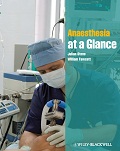A 71-year-old man with a history of hypertension and ischaemic heart disease is undergoing primary hip arthroplasty. He has had a spinal anaesthetic (hyperbaric bupivacaine and diamorphine) and is sedated with propofol by continuous infusion. He develops wheeze, a widespread rash and becomes hypotensive soon after administration of prophylactic antibiotics.
-
1. What type of reaction is this?
Show Answer
Correct answer: This is likely to be an acute Type 1 allergic reaction (anaphylaxis). Histamine, complement and other inflammatory mediators are released (e.g. from mast calls and basophils) as a result of IgE–antigen interaction.
-
2. Describe the initial treatment.
Show Answer
Correct answer: The initial treatment is based on the Airway Breathing Circulation approach:
- 100% oxygen is given, and the trachea intubated if necessary.
- The surgeon must be informed of the diagnosis, and surgery not started or its progression halted if at all possible.
- Stop giving the antibiotic or other drug in question.
- Elevate the legs to help venous return.
- Start CPR if indicated.
- Adrenaline boluses, as 50 μg increments, is given i.v.
- Salbutamol i.v. or as a nebulizer, aminophylline or magnesium might be used for the treatment of bronchospasm.
- Intravenous fluids.
- Chlorpheniramine and hydrocortisone as second-line treatments.
- The patient should be transferred to HDU/ICU once stable.
-
3. What follow-up should he have?
Show Answer
Correct answer: Serum samples should be taken for mast cell tryptase (three samples: as soon as is practical, 1–2 hours later and at 24 hours or follow-up).
Patients must be followed up with referral to an allergy specialist as well as investigations (e.g. skin prick testing and intradermal testing). Patients must be informed of any significant positive allergy findings to avoid subsequent exposure.
-
4. What are the differential diagnoses?
Show Answer
Correct answer: The main differential diagnosis would be of bone cement implantation syndrome. Both this and anaphylaxis can cause hypotension, histamine release, hypotension and a reduction in oxygen saturation.
The initial management of both would be along the ABC lines of resuscitation, establishing a secure airway, ensuring adequate lung ventilation (either spontaneously or with assisted ventilation) and circulation with i.v. fluids and vasopressors as required.

